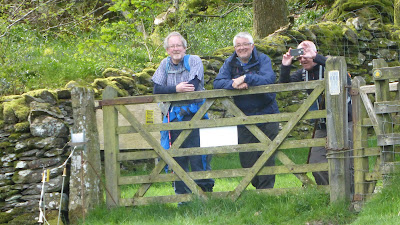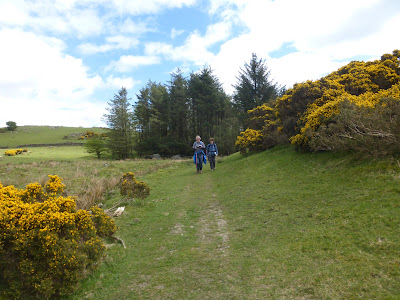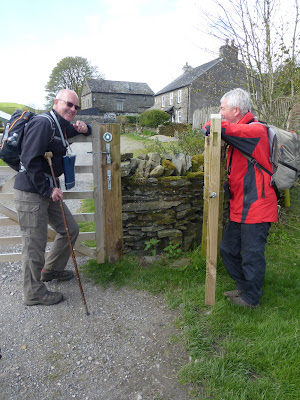St Bart's Hospital is the oldest hospital in Britain that still provides medical care from its original site. Bart's was founded in 1123 by Rahere, an Anglo-Norman priest and Monk. It survived both The Great Fire of London and the Blitz and being a hospital it was not affected by the Dissolution of the Monasteries (1536-41). However, that act did mean an end to its income and consequently Henry VIII refounded the hospital in 1546 by signing an agreement granting the hospital to the Corporation of London.
 This is the main public entrance to the hospital, the King Henry VIII gate. The statue above the gate is the only remaining statue of him in London.
This is the main public entrance to the hospital, the King Henry VIII gate. The statue above the gate is the only remaining statue of him in London.

Whereas all hospitals will have a chapel, St Barts is the only hospital to have a parish church within its grounds. St Bartholomew-the-Less has a 15th Cent tower and vestry. It was very difficult to photograph as I couldn't get back far enough.

Inside is this early 20th cent stained glass window of a nurse.
This is the 18th Cent square created by James Gibbs. Overlooking the square in the hospital's historic North wing is St Bart's Museum.
Displayed in the museum are copies of Rahere's grant of 1137 and the 1546 agreement between Henry VIII and the City of London.
This is an original document from 1331 bearing the new seal of the hospital.
This is the hospital ledger from 1726
Ledgers were kept by the hospital from 1547 as a record of the money received and paid out. This page shows the annual salaries paid to staff. You can't help admiring that beautiful handwriting.
Other displays include surgical instruments like this case of amputation equipment.It is believed that this case belonged to the founder of the medical school John Abernethy(1764-1831). Before
anaesthetics, the speed of operation was very important to minimise not only the pain but the loss of blood.
There are also audio tapes describing how the lives of doctors and nurses have changed over the centuries. It is a small but very interesting museum with lots of snippets of information that grab your attention.
'No women, including sisters, were allowed in the men's ward after 7 o'clock. Any patients who swore, blasphemed, were disobedient or refused to go to bed were punished in the stocks after one warning.'
 At the back of the museum is the Grand Staircase leading to the Grand Hall. (This is not accessible to the public but the staircase can be seen through the doorway.) The governors wanted to have a spectacular entrance and considered inviting a Venetian artist to decorate the walls. However, William Hogarth (1697-1764) heard of their intentions and offered his services for free. He was well known for his paintings at the time and his generous offer was not to be missed. The two vast paintings were completed between 1734-37.
At the back of the museum is the Grand Staircase leading to the Grand Hall. (This is not accessible to the public but the staircase can be seen through the doorway.) The governors wanted to have a spectacular entrance and considered inviting a Venetian artist to decorate the walls. However, William Hogarth (1697-1764) heard of their intentions and offered his services for free. He was well known for his paintings at the time and his generous offer was not to be missed. The two vast paintings were completed between 1734-37.

Just outside the museum is a collection box for the poor. It looks Victorian but I haven't been able to confirm the date. If you are in the Smithfield part of London then have a look at this small museum. Admission is free although donations are always welcome.
Sharing with Our World Tuesday
 This is the main public entrance to the hospital, the King Henry VIII gate. The statue above the gate is the only remaining statue of him in London.
This is the main public entrance to the hospital, the King Henry VIII gate. The statue above the gate is the only remaining statue of him in London.

Inside is this early 20th cent stained glass window of a nurse.
This is the 18th Cent square created by James Gibbs. Overlooking the square in the hospital's historic North wing is St Bart's Museum.
This is an original document from 1331 bearing the new seal of the hospital.
This is the hospital ledger from 1726
Ledgers were kept by the hospital from 1547 as a record of the money received and paid out. This page shows the annual salaries paid to staff. You can't help admiring that beautiful handwriting.
Other displays include surgical instruments like this case of amputation equipment.It is believed that this case belonged to the founder of the medical school John Abernethy(1764-1831). Before
anaesthetics, the speed of operation was very important to minimise not only the pain but the loss of blood.
There are also audio tapes describing how the lives of doctors and nurses have changed over the centuries. It is a small but very interesting museum with lots of snippets of information that grab your attention.
'No women, including sisters, were allowed in the men's ward after 7 o'clock. Any patients who swore, blasphemed, were disobedient or refused to go to bed were punished in the stocks after one warning.'
 At the back of the museum is the Grand Staircase leading to the Grand Hall. (This is not accessible to the public but the staircase can be seen through the doorway.) The governors wanted to have a spectacular entrance and considered inviting a Venetian artist to decorate the walls. However, William Hogarth (1697-1764) heard of their intentions and offered his services for free. He was well known for his paintings at the time and his generous offer was not to be missed. The two vast paintings were completed between 1734-37.
At the back of the museum is the Grand Staircase leading to the Grand Hall. (This is not accessible to the public but the staircase can be seen through the doorway.) The governors wanted to have a spectacular entrance and considered inviting a Venetian artist to decorate the walls. However, William Hogarth (1697-1764) heard of their intentions and offered his services for free. He was well known for his paintings at the time and his generous offer was not to be missed. The two vast paintings were completed between 1734-37.
Just outside the museum is a collection box for the poor. It looks Victorian but I haven't been able to confirm the date. If you are in the Smithfield part of London then have a look at this small museum. Admission is free although donations are always welcome.





































































